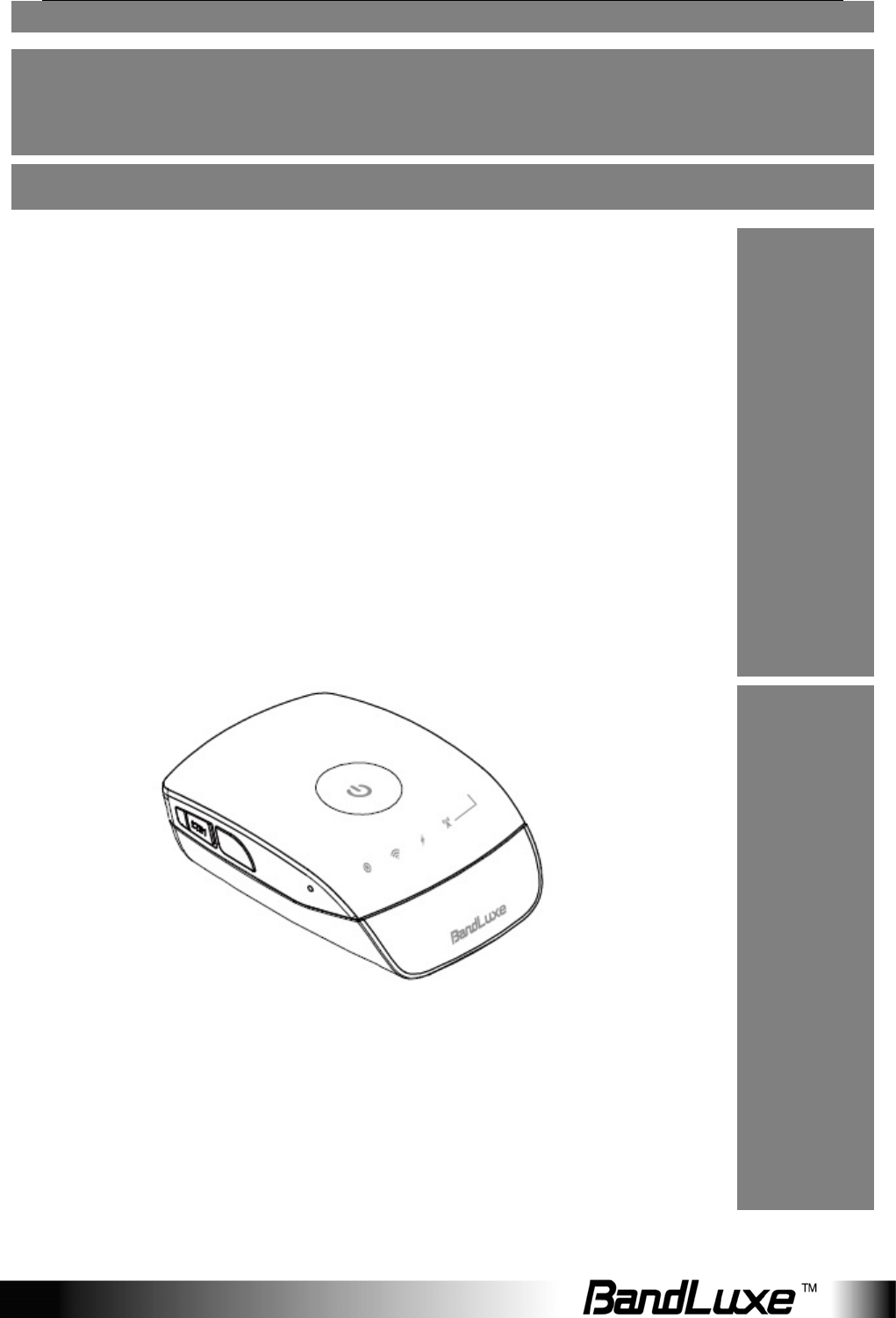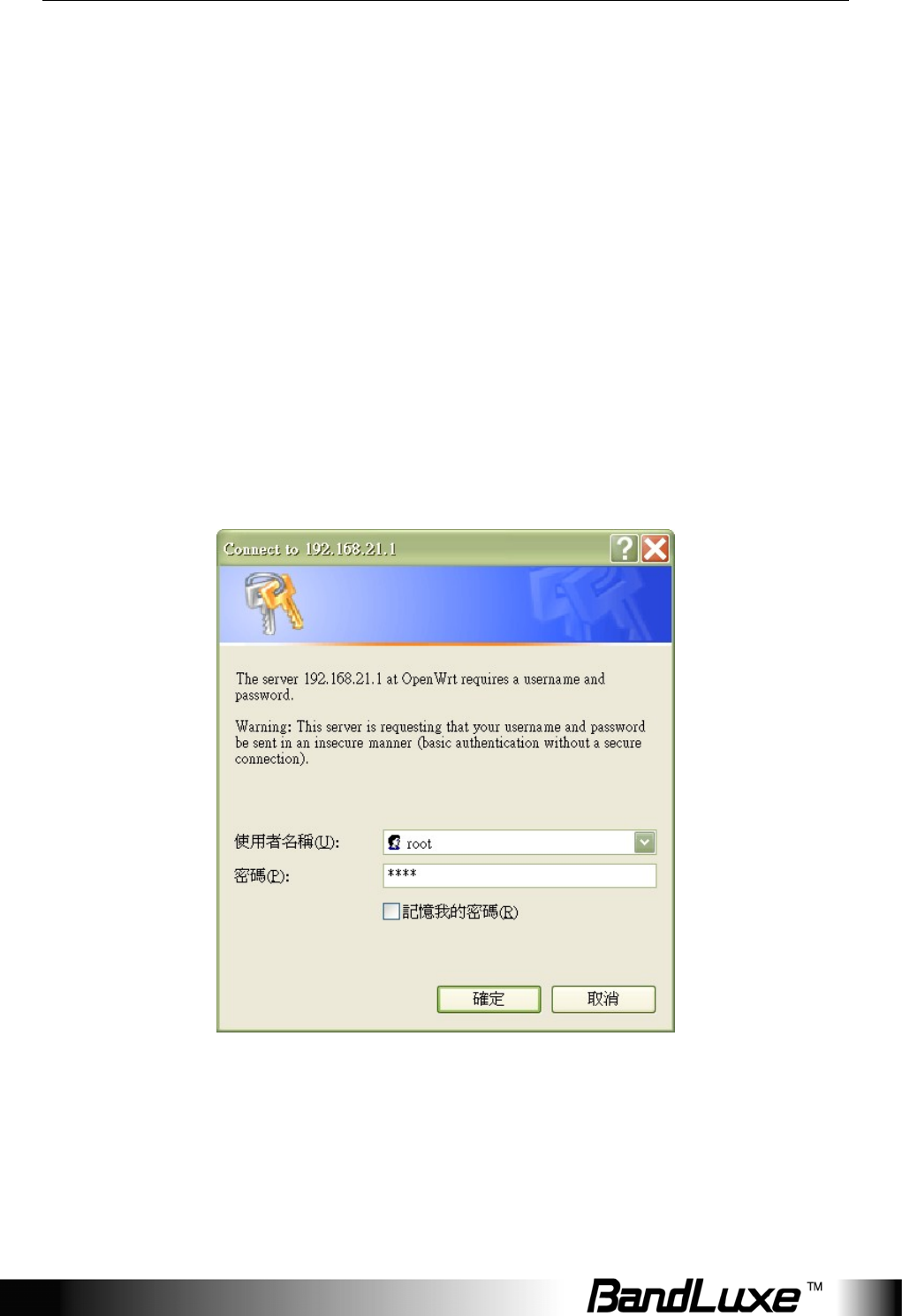BandRich P530A LTE/HSPA + Mobile Router User Manual P530 series for FCC
BandRich Inc. LTE/HSPA + Mobile Router P530 series for FCC
BandRich >
User Manual

User
Manual
BandLuxe
P530 Series
LTE/HSPA+/GPRS WLAN Mobile
Router

1
Introduction
Thank you for your purchase of the P530 Series LTE/HSPA+/GPRS WiFi
Mobile Router. This device is designed to access the Internet via 4G
technology and share the Internet through a WLAN network. You can also
share files with your friends with an optional microSD card. P530 is
portable and easy to use. Reading the user manual will help you make
the most use of your product.
Features
LTE/HSPA+/GPRS WLAN Mobile Router
WPS Support
Supports up to 10 simultaneous wireless users
Supports optional microSD card (up to 32 GB)
Uplink speeds up to 50 Mbps
Downlink speeds up to 100 Mbps
Supports WLAN 802.11 b/g/n
Operating Frequency Bands
o LTE: 700/AWS/1900
o UMTS/HSPA+: 900/2100 MHz
o GSM: 850/900/1800/1900 MHz
External 4G Antenna Port Ready

Getting Started
2
Getting Started
This chapter will provide a hardware overview of the P530 Series
LTE/HSPA+/GPRS WLAN Pocket Router step by step instructions on
installing the device.
Package Contents
1.
1.
1. P530 series LTE/HSPA+/GPRS WLAN Pocket Router
2. Power Adapter
3. Battery
4. USB cable
Installation
1. Remove the back cover of the device.
2. Insert the SIM card into the slot. Ensure the SIM card orientation
matches the SIM card slot.
3. Insert the microSD card (optional) into the slot with the metal contacts
facing down and towards the slot.
NOTE: The optional microSD card allows for file sharing between PCs on
the same network when the P530 is connected via the USB
cable/WLAN to the client .
4. Insert the battery. Ensure the battery contacts are properly oriented.
5. Replace the back cover of the device.
6. Connect the power adapter to the router. Plug the power adapter into a
wall outlet to charge the battery.
Warning: To prevent the battery from overheating, do not
charge the device for long periods of time while using.
NOTE: When the USB cable is connected to a PC, the cable provides

Getting Started
3
4G connectivity. The USB port may not provide sufficient charge to
replenish battery power. To charge the battery, use the power
adapter to connect the device to a wall outlet.
7. Link the router to your PC.
To link the router to your PC via a wireless connection, in Microsoft
Windows, go to Control Panel > Network Connections. Right click
on the Wireless Network Connection and choose View Available
Wireless Networks. Select the SSID and enter the password (see
the network information card in the box) and click Connect.
To link the router to your PC via a USB connection, connect the
USB cable to the device and PC. Microsoft Windows automatically
installs RNDIS drivers and establishes a local area connection, as
indicated by the Local Area Connection icon on your PC.
USB Connectivity
If the USB cable is connected between the device and a PC, the device
establishes a local area connection, indicated by the Local Area
Connection icon on the client PC, and a connection to the Internet via the
user's mobile network connection, such as HSPA.
If the USB cable is not used, the device may function as a wireless router
and/or an Internet access point.
As a wireless router, the PR-30 is capable of supporting up to 10
simultaneous wireless connections. In addition, the device allows users to
share a single Internet connection.
If a microSD card is installed, the card may be used as a common
storage space among the connected PCs. P530 series support
microSD cards up to 32GB.
USB No USB
Internet Access Yes Yes
Wireless connections No 10 simultaneous
File sharing Yes Yes

Getting Started
4
Basic Functions
Powering On and Off
To power the P530 on, slide the device up to the ON position. When
the P530 is powered on, the LEDs start blinking (approximately 16
secs).
Enabling WPS
WPS is a standard designed to easily setup and automatically configure
secure WLAN networks between two WPS supported devices. If the
client PC supports WPS, the WPS feature can be a user-friendly and
simple process to get your WLAN network up and running.
1. Enable WLAN.
2. Press and hold the WPS button for at least 5 seconds.
3. Confirm the WPS option on the client PC trying to connect to the
P530. WPS connecting device followed by New device
connected is displayed.
Note: The safe temperature range for discharging and
charging the battery is as follows:
Charging temperature: 0~40 degrees Celsius, maximum
45 degrees Celsius; once temperature exceeds 45
degrees the device will stop charging.
Warning: When using in normal temperature environments,
high battery power consumption may cause the battery
temperature to exceed 45 degrees and thus stop charging if
connected to a wall outlet. It is not recommended to charge
and use the device at the same time.
Discharging (operating) temperature: 20~60 degrees Celsius,
maximum 75 degrees Celsius; once temperature exceeds 70
degrees the device will power off.

P530 Series Management
5
P530 Series Management
Accessing the Device
P530 WLAN Router uses the web-based interface for managing and
configuring wireless network settings. To access the interface, open a
browser such as Internet Explorer and enter the router’s default IP in the
browser’s address bar. Use the appropriate IP depending on the
connection method.
Connection method Default IP
USB 192.168.21.1
WLAN 192.168.100.1
When the login window appears, enter the default username, root, and
default password, 1234.

P530 Series Management
6
Basic Setup
SSID Network name of your WLAN network. It is case sensitive and can
not exceed 14 characters. Default name is printed on the network
information card.
Encryption Type Method of encryption used when transferring data
through the airwaves from the router to the client PC or vice versa. The
PR-30 WLAN Router supports 3 encryption types - WEP, WPA, and
WPA+WPA2.
WPA is a WLAN standard that was designed to improve the security
features of WEP. WPA2 is a more advanced, more secure version of
WPA.
Passphrase (WEP only) Sequence of words or text used to automatically
generate a WEP Key. Enter a value between 8-63 characters.
WEP Key 1-4 (WEP only) Key required to decipher the data encryption
method. At least one key must be entered. Use a pre-existing passphrase
by selecting Generate 40bit Key or Generate 128bit Key or manually
enter a WEP Key (letters from A-F and numbers 0-9). 40-bit WEP Keys
require 10 hexadecimal digits and 128-bit WEP Keys require 26
hexadecimal digits.
WPA Pre-Shared Key (WPA and WPA+WPA2) Key required to decipher
the data encryption method. Enter a value between 8-63 characters. This
field must not be left blank.

P530 Series Management
7
Specifications
Note: Specifications are subject to change without notice.
Physical
WLAN 802.11 b/g/n with 1x1 antenna design (no
diversity).
Coverage : 10m
Cellular modem Embedded,
GPRS/EDGE/WCDMA/HSPA/HSPA+/LTE
Dimension (LxWxH, mm) L 74.17 x W 52.41 x H 24.09 mm
Weight (g) 42g without battery ; 48g with battery
Interface
USB interface for PC connection Support tethering connectivity to PC with
driver
GPS interface NMEA port supported
Power Switch Power on/ off by slider design
Wake-up/WPS Button Short press to wake up device from sleep
mode
Long press (>5s) for WPS activation
WiFi on/off switch Embedded beneath battery for special
use of WiFi signal off
Power supply plug Yes, charging via Micro-USB
SIM slot Yes, hidden under battery
MicroSD slot Yes, support up to 32 Gbytes, hidden
under battery
Operation Modes 1) USB & WiFi simultaneous
2) WiFi only
3) USB only (WiFi can be turned off by
hardware switch or by software switch)
Device Power States 1) Active State
2) Sleep State

P530 Series Management
8
Federal Communication Commission Interference Statement
This device complies with Part 15 of the FCC Rules. Operation is subject to the
following two conditions: (1) This device may not cause harmful interference, and (2)
this device must accept any interference received, including interference that may
cause undesired operation.
This equipment has been tested and found to comply with the limits for a Class B
digital device, pursuant to Part 15 of the FCC Rules. These limits are designed to
provide reasonable protection against harmful interference in a residential installation.
This equipment generates, uses and can radiate radio frequency energy and, if not
installed and used in accordance with the instructions, may cause harmful
interference to radio communications. However, there is no guarantee that
interference will not occur in a particular installation. If this equipment does cause
harmful interference to radio or television reception, which can be determined by
turning the equipment off and on, the user is encouraged to try to correct the
interference by one of the following measures:
- Reorient or relocate the receiving antenna.
- Increase the separation between the equipment and receiver.
- Connect the equipment into an outlet on a circuit different from that
to which the receiver is connected.
- Consult the dealer or an experienced radio/TV technician for help.
FCC Caution: Any changes or modifications not expressly approved by the party
responsible for compliance could void the user's authority to operate this equipment.
This transmitter must not be co-located or operating in conjunction with any other
antenna or transmitter.
Radiation Exposure Statement:
The product comply with the FCC portable RF exposure limit set forth for an
uncontrolled environment and are safe for intended operation as described in this
manual. The further RF exposure reduction can be achieved if the product can be kept
as far as possible from the user body or set the device to lower output power if such
function is available.